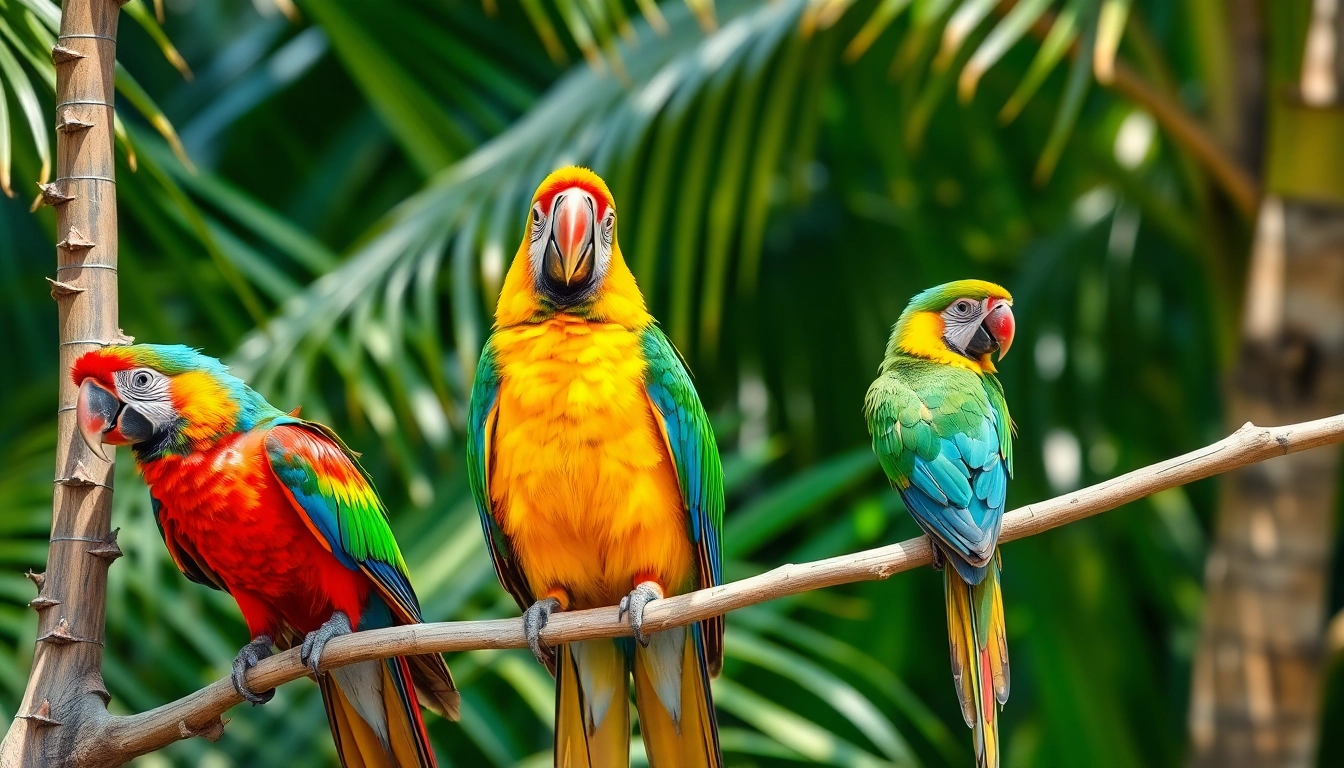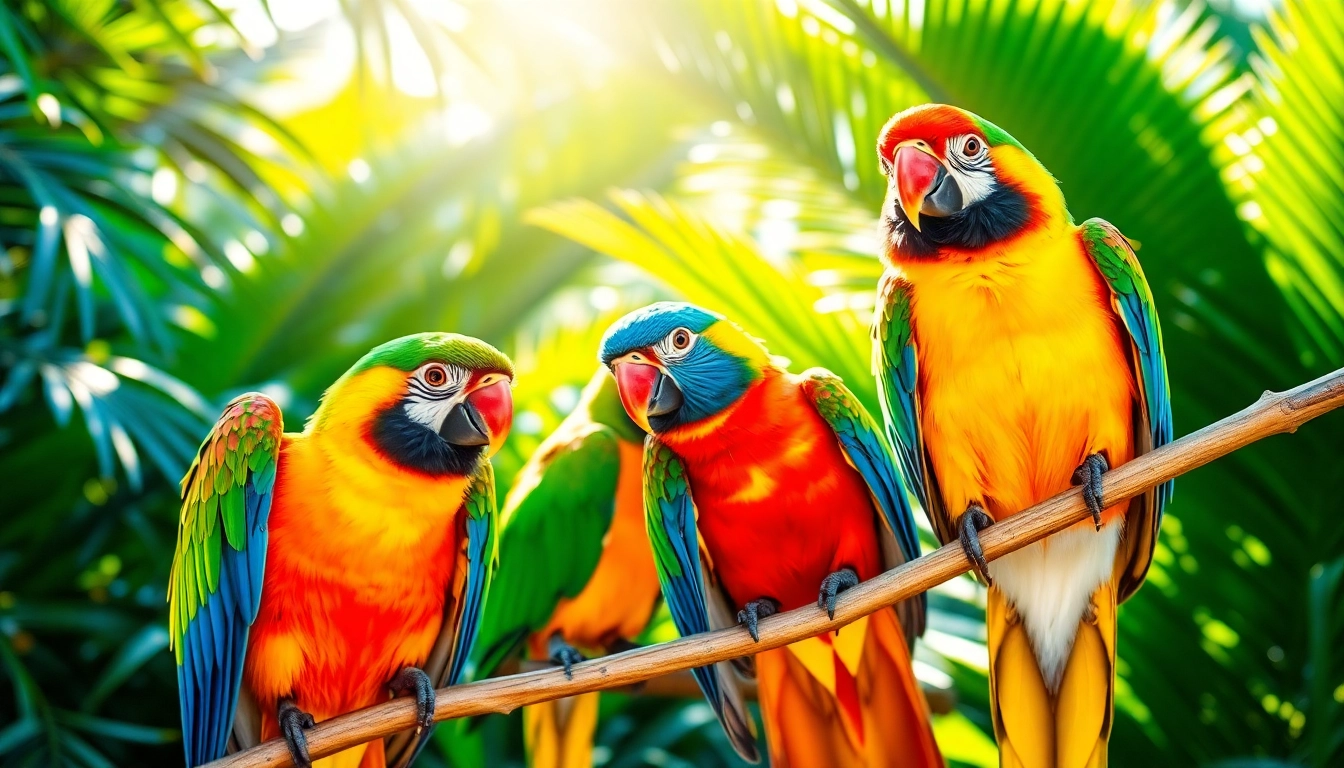
Introduction to Parrots: The World’s Most Intelligent Birds
Parrots, scientifically known as Psittaciformes, captivate bird enthusiasts and casual onlookers alike with their vivid plumage, remarkable intelligence, and engaging behaviors. These birds, often associated with tropical environments, possess unique characteristics that set them apart in the avian world. Their ability to mimic sounds, strong social bonds, and complex communication skills make them fascinating subjects for study, conservation, and companionship.
If you’re considering welcoming a parrot into your home or simply want to deepen your understanding of these extraordinary birds, this comprehensive guide will navigate through their defining traits, species diversity, care needs, behavioral intricacies, and conservation efforts. Dive into the colorful, intelligent, and complex world of parrots, and discover why they are truly among the most captivating avian species on Earth.
What defines a parrot? Key characteristics and behaviors
Parrots are distinguished primarily by their distinctive physical features and behavioral traits, which have fascinated biologists and pet owners for centuries.
Physical Characteristics
- Strong Curved Beak: Parrots possess a powerful, curved beak designed for cracking nuts, peeling fruit, and manipulating objects. This beak is a hallmark feature, providing both feeding and grooming capabilities.
- Upright Stance and Clawed Feet: Their stance is notably upright, with zygodactyl feet—two toes face forward, and two face backward—allowing excellent grasp and dexterity for climbing and handling food or toys.
- Vibrant Plumage: The bright, often multi-colored feathers not only serve as camouflage in dense foliage but also play roles in social signaling and mating displays.
Behavioral Traits
- Intelligence and Problem-Solving Skills: Parrots rank among the most intelligent bird groups. They demonstrate problem-solving abilities, can learn tricks, and are capable of understanding basic concepts.
- Vocalization and Mimicry: Their ability to mimic human speech and other sounds is well-known. This vocal capacity is a form of social interaction and bonding and varies significantly among species.
- Social Structure: Parrots are highly social creatures, often living in flocks that can range from small groups to hundreds of individuals, depending on the species and environment.
In addition to their physical and behavioral features, parrots exhibit strong attachment behaviors, including preening, vocalizing, and seeking physical contact with companions, whether other parrots or humans. This social nature underscores the importance of proper enrichment and interaction for pet parrots to thrive both physically and psychologically.
Parrot species overview: Major families and unique traits
Understanding the diversity within the parrot order reveals the incredible variety of forms, sizes, and lifestyles these birds embody. They are classified primarily into four families, each with its distinct evolutionary traits and adaptations.
The Major Parrot Families
- Psittacidae (True Parrots): This is the largest family, including the well-known Amazon parrots, macaws, and African grey parrots. These species are renowned for their intelligence and vibrant colors.
- Cacatuidae (Cockatoos): Characterized by their prominent crest feathers and predominantly found in Australasia, cockatoos are notable for their expressive crests and sociability.
- Strigopidae (Kākāpō and Strigops): Native to New Zealand, these include the critically endangered kākāpō, a flightless or nearly flightless parrot known for its nocturnal and flightless traits.
- Psittrichasiidae (Monk and Hanging Parrots): Less commonly discussed, these include species adapted to specific habitats, often with distinctive behaviors.
Unique Traits and Adaptations
- Size Variations: From small conures weighing around 100 grams to large hyacinth macaws exceeding 1.5 kilograms, the size spectrum influences diet, habitat, and social structures.
- Dietary Specializations: Some parrots are seed specialists, while others have adapted to a more omnivorous diet, including fruits, nuts, and occasionally insects.
- Reproductive Behaviors: Many species form lifelong pair bonds and exhibit elaborate courtship displays, vital for success in conservation efforts.
Each species’ unique traits contribute to their ecological niches and make them suitable for different environments and captivity requirements. Recognizing this diversity is crucial for conservation, research, and responsible pet ownership.
The global distribution of parrots and natural habitats
Parrots are primarily tropical and subtropical birds, with a distribution that spans continents and islands, reflecting their extensive evolutionary history and habitat adaptability.
Natural Habitats
Parrots thrive in a variety of ecosystems, including:
- Rainforests: Dense tropical forests of South America, Australasia, and Southeast Asia provide rich food sources and complex arboreal environments.
- Woodlands and Savannas: In regions like Africa and Australia, parrots inhabit open woodlands, where they nest and forage on diverse plant material.
- Coastal and Island Habitats: Many species have adapted to island life, such as the kākāpō in New Zealand or the island-dwelling lorikeets and lovebirds.
Distribution Highlights
Most parrots are native to:
- South America: The Amazon Basin hosts a plethora of species, including macaws and Amazons.
- Australasia: Australia, New Zealand, and surrounding islands house cockatoos, parakeets, and native specialty species like the kākāpō.
- Africa: Species such as the grey-headed parrot and Rose-ringed parakeet are widespread.
- Asia: India, Southeast Asia, and the Philippines contain diverse parrots, many of which face habitat loss threats.
Understanding these distributions helps conservationists focus on habitat preservation and control invasive species, especially as some parrots, like the Monk parakeet, have established populations outside their native ranges, sometimes threatening local ecosystems.
Popular Parrot Types and Their Care Needs
The Most Common Pet Parrots: Amazons, Cockatoos, and Conures
Among the plethora of parrot species kept as pets, several stand out due to their intelligence, manageable size, and social behaviors. Knowing their specific care requirements ensures a harmonious cohabitation.
Amazon Parrots
- Size: About 12-15 inches; weight around 1-1.5 pounds.
- Appearance: Vivid green bodies with bright colored facial patches; some species have purple or red accents.
- Traits: Highly trainable, excellent talkers, and affectionate, but require mental stimulation and large cages.
Cockatoos
- Size: Ranging from 16 inches (e.g., umbrella cockatoo) to over 20 inches (e.g., palm cockatoo).
- Appearance: Predominantly white or black with expressive crest feathers.
- Traits: Very social, requiring interaction and environmental enrichment; prone to feather-plucking if bored.
Conures
- Size: Smaller, around 12 inches, making them popular for apartment living.
- Appearance: Bright green, orange, yellow, and red plumage, depending on species.
- Traits: Playful, intelligent, and affectionate, but can be noisy.
Choosing the Right Parrot for Your Home
When selecting a parrot species as a pet, consider:
- Space Availability: Larger parrots like cockatoos need spacious cages and frequent out-of-cage time.
- Experience Level: Beginners may prefer smaller, less demanding species like budgerigars or certain conures.
- Time Investment: Highly intelligent parrots require mental stimulation, social interaction, and environmental enrichment daily.
- Noise Tolerance: Some species are inherently loud, which can affect household harmony.
Essential Care Practices for Healthy Parrots
Proper care is fundamental for ensuring your parrot’s well-being. These practices include:
- Balanced Diet: A mix of high-quality pellets, fresh fruits, vegetables, and occasional nuts or grains tailored to the species.
- Housing: Spacious cages, perches of varying sizes, and safe toys to promote physical activity and mental engagement.
- Social Interaction: Daily bonding sessions and environmental enrichment prevent loneliness and destructive behaviors.
- Health Monitoring: Regular veterinary check-ups, quarantine procedures for newcomers, and awareness of common health issues such as feather plucking or respiratory problems.
Adherence to these guidelines maximizes lifespan and quality of life for pet parrots, which can reach decades with proper care.
Training and Behavioral Skills of Parrots
Teaching Parrots to Talk: Techniques and Patience
Mimicry and vocal learning are some of the most celebrated traits in parrots. Successful training involves patience, consistency, and a positive reinforcement approach.
Begin by dedicating daily sessions to repetition of simple words or phrases, using a calm tone. Repetition paired with rewarding a parrot with favorite treats or praise accelerates vocabulary acquisition. African grey parrots are particularly adept at speech, with some individuals mimicking human voices remarkably accurately.
For more insights on talking parrots, visit Talking birds – Wikipedia.
Bonding Behaviors: How Parrots Show Affection
Parrots exhibit their attachment through behaviors like preening their owners or flock mates, vocalizing softly, and seeking physical contact. Mimicking sounds and speech is also a form of social bonding, demonstrating trust and affection. Recognizing these behaviors helps owners deepen their connection and foster mutual understanding.
Managing Noisy and Destructive Behaviors Effectively
Many parrot owners face challenges related to loud calls and destructive chewing. Address these by providing adequate mental stimulation through toys, puzzle feeders, and environmental variation. Regular interaction reduces boredom, which often leads to undesirable behaviors. In cases of excessive noise, establishing a routine and positive reinforcement for quiet periods can mitigate disturbances.
Conservation and Ethical Considerations
Threats Facing Wild Parrot Populations Worldwide
The wild populations of parrots face numerous threats, intensifying the importance of conservation efforts. Major threats include habitat destruction from deforestation, illegal trapping for the pet trade, and climate change impacts.
Many species, such as the kākāpō and certain macaws, are critically endangered, emphasizing the urgency to implement sustainable conservation strategies.
How to Support Parrot Conservation Efforts
Individuals can contribute to conservation via donations to reputable organizations like the World Parrot Trust or participating in habitat restoration projects. Supporting legal and ethical wildlife trade practices is essential, ensuring that wild populations are protected rather than exploited.
Responsible Pet Ownership and Avoiding the Illegal Trade
Adopting parrots from reputable breeders or rescue organizations is key to reducing illegal trade. Educating oneself on species-specific needs and preventing the purchase of parrots captured from the wild minimizes the demand for wildlife trafficking. Additionally, advocating for stronger legislation and enforcement deters illegal smuggling.
Fun Facts and Myth Busting About Parrots
Surprising Traits and Abilities of Parrots
- Remarkable Lifespans: Some large parrots like the Hyacinth macaw can live up to 50 years or more in captivity, making them lifelong companions.
- Feet and Tool Use: Parrots eat with their feet, and certain species have been observed using tools to obtain food, highlighting their advanced problem-solving skills.
- Vocal Abilities: Parrots are among the few animals capable of mimicking human speech and other sounds with high accuracy, often resembling the human voice closely.
The Lifespan and Intelligence of Different Species
Species diversity influences lifespan and cognitive abilities. For instance, cockatoos tend to live 40-60 years, while smaller species like lovebirds may live about 10-15 years. African grey parrots are considered some of the most intelligent species, capable of understanding complex concepts and demonstrating problem-solving skills.
Common Misconceptions About Parrots and Their Care
- Myth: Parrots can thrive in small cages.
Fact: They require large, stimulating environments and plenty of out-of-cage time. - Myth: Parrots are low-maintenance pets.
Fact: Their intelligence requires daily mental stimulation, social interaction, and health monitoring. - Myth: Parrots do not form bonds or attachments.
Fact: Parrots are highly social and form strong bonds with owners and flock mates, necessitating attentive care.
By debunking these myths, potential and current owners can provide better care and foster healthier, happier relationships with their parrots.







